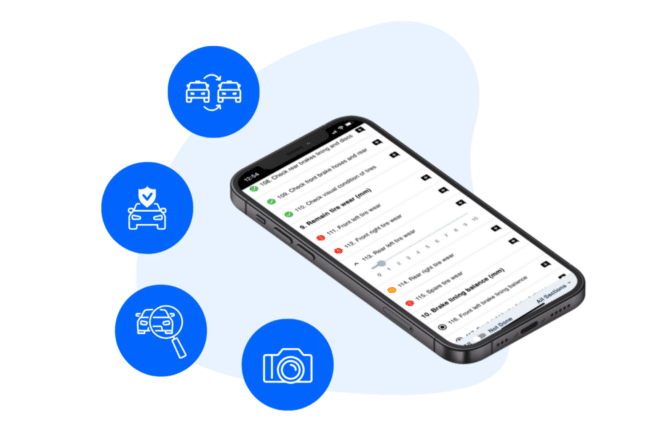We had a chat with Janek Prümmel, the Sales Director and a member of the board at Modera. With his extensive experience and knowledge in sales and the automotive industry, Janek gives us great insights into the world of car trade-ins. He explains how car price estimates are made, discusses emerging processes in car sales for the upcoming years and much more.

Please introduce yourself and tell us what you do at Modera.
My responsibilities include finding new clients, managing communication with existing clients, and exploring expansion and new regions. I also handle the recruitment and management of salespeople and do a lot of sales work myself, prepare proposals, and conduct client analysis. I try to stay informed about product development. I’m more of a specialist than a born salesperson. I speak what I know and promise what I can deliver. I communicate with the product department regularly and keep track of all the updates to understand what we’re doing.
In your opinion, what is the best sales strategy? What kind of sales do you not tolerate at all?
For sales to succeed, there must be a need on the other side for the product or service being offered. Often, something is pushed on people, making them believe they need it when they actually don’t. Such sales may occur, but the end result is usually that the customer isn’t satisfied. The offering and demand should align to some extent. I avoid over-promising. Instead, I try to understand what the pain points are and whether we can help or not.
If someone is considering whether to do a trade-in or sell their car independently, what should they consider?
I think it comes down to convenience. Of course, it also depends on the region. For example, in Estonia, we are used to selling our cars ourselves to get a better price. However, we are also moving towards valuing convenience. People don’t always want to bother with showing their car in a parking lot to potential buyers. It’s easier to go to a car dealer and let them handle the process for you. On the other hand, that convenience comes at a cost. You probably won’t get the amount of money you initially hoped to get for your car. However, the final sum might not be that important when everything is well managed, there are no risks, and no one is trying to deceive the buyer.
Can you provide an example of a country with a different car sales culture?
The Baltic and Eastern European countries are not yet at the level of Northern or Central Europe. For example, if you look at Finland, Sweden, or UK, these are well-developed markets where the culture of selling used cars is on a completely different level. It’s common for people to do trade-ins rather than sell their cars themselves. In some countries, deals are even made without seeing the car in person. In those cases cars are assessed based on photos. There’s a higher level of trust between the buyer and the seller.
What does trade-in usually look like?
There are three steps in a trade-in process.
- The customer fills out a web form to sell their car. Based on this, the car seller knows the make, model, and year of the car, which allows them to provide an initial price range based on the market prices. For example, €15,000 – €20,000.
- A quick initial inspection, which can also be done by a new car salesperson. They take some pictures and provide a more precise price estimate based on these. It’s because in the case of a trade-in, when a customer is looking at a new car, they want some estimate for their old car.
- To determine the final price, the car needs to be technically inspected. A car mechanic checks its technical condition, and performs, for example, a 50- or 150-point inspection. This includes for example examining the tire tread, paint thickness in different areas, and many other things. This process can take several hours. With newer cars, the software is checked during this process as well. Any faults in the car and the cost of repairing them are identified. The final car price quote is then provided. Some may skip the final step and make a riskier purchase.
How is the data obtained for the first step?
In developed countries where the used car business is well-established and great quantities of cars are sold, such as Finland and Sweden, there are databases available. These databases contain information about how many cars of a particular make and model are on the market and how they are priced.
There are actually several approaches to pricing. The simplest but not very accurate method is to look at classified ads, find all similar cars for sale, and make a small calculation based on factors like mileage. This method provides the prices that people want for their cars but doesn’t provide the actual selling price. For example there are portals that collect information from different car sales portals and draw their own conclusions. This method is considered the least accurate. Another option is to gather information from sales systems, such as the Modera platform, which has transaction prices. You collect the sales history and calculate market averages based on that data. This method is much more accurate, but the information is harder to obtain. The third option is using a market price calculator. Some of these calculators are quite large, like Indicata and Autovista in Europe. They work in major markets like France, Germany, the UK, etc. In addition to buying information from sales platforms, they rely heavily on auction environments where many used cars pass through. Therefore, information collection from websites is the lowest quality, while auction center data is at the top.
Once the initial price is established, is the second step even necessary?
The second step is necessary when the customer doesn’t come via the web and comes directly to the dealership. It’s often easier to communicate face to face and handle things in person, and I believe that’s where the importance of the second step lies.
I have a good story to illustrate this. One dealership, a client of ours, had a practical issue. They have two showrooms a few kilometres apart, one for new cars and one for used cars. When a customer came to see a new car and immediately showed their current car in the yard, asking how much they would get for it, the salesperson would tell them to take a trip to the other, used car showroom to get their car evaluated.
This might have resulted in the customer leaving and going somewhere else instead. The dealership didn’t like making their customers go back and forth. This is where the idea of the new car salesperson performing the initial inspection and sending the information to the used car department came from. This was also the beginning of Modera’s current product.
How did you reach the point of developing your own car sales and CRM software?
Modera initially started by creating websites for car dealerships. This is still one of our areas of focus. We continue doing this because of customer buying habits – they are moving more and more online.
Another direction we took was in sales and CRM solutions. This originated from a customer’s need. Back in 2014 or 2015, Nissan decided to change its dealership concept. They wanted to make the showroom experience more pleasant for the customer. They aimed to create a lounge-style environment with amenities like coffee machines, tables, sofas, plants, and more. They wanted to create a new atmosphere where customers and salespeople could meet. They wanted to eliminate the cubicle setup where the salesperson sat on one side, and the customer sat on the other side of the glass. The goal was to make customer interactions more enjoyable. They wanted to put a sales platform on a tablet, so their sales people could use it comfortably. That’s how we started creating a sales system for tablets.
At first, the solution was simple, allowing the salesperson to make offers and showcase additional equipment. However, customers still had to leave with a stack of paperwork. This is where it all began. Then we started looking into digitising the sales process further. We knew who our competitors were – solutions that were somewhat outdated, around 30 years old (solutions that were not web-based). So, we started developing. We added lead management, test drives, inventory features, contracts, and invoices. Today, we have developed a sales system where dealerships can handle all their sales matters. The next logical step was to develop a feature that supports trade-ins, as trade-ins have become such an important part of the process (for every two cars sold, one is taken as a trade-in). We initially focused on car dealerships but have now shifted to manufacturers. When we’re currently looking for customers, we primarily approach car factories.
What does the trade-in process look like when using Modera’s software?
The idea of the application is to allow the new car seller, who might not be skilled in assessing cars, to provide an initial price estimate. They are usually the first people to meet the customer. In the application, the car is registered, and there are predefined steps where the salesperson records information about the car’s equipment, which ultimately affects its price (significant factors like leather seats, navigation system, etc.). Not every element of equipment needs to be documented if it doesn’t affect the price. The salesperson takes some photos of the car, including any damages if present, documenting and compiling the basic information. Ideally, based on this material, the person responsible for valuing the car should be able to provide an initial estimate. The advantage is that the used car buyer doesn’t need to be physically present; they can work from somewhere else. Additionally, everything is documented. Otherwise, this information would be on paper or in emails, and no one would know who has been involved and what prices have been offered. With this application, a clear digital trail is left behind.

In your experience, how often does the difference between the initial and final price quote disappoint customers?
Every subsequent quote is always lower. Explaining why the price difference occurred is part of the salesperson’s job. It’s an art of salesmanship. If you can explain it well and highlight the necessary procedures that must be performed on the car, the customer usually better understands the offered price.
I recently visited Finland, and there, automatic pricing is widely used and generally trusted. In Finland, the government has made it mandatory for all car importers to submit their car price lists. As soon as a new price list comes in, they have to input it into the national system (because calculating the car tax there is quite complex). They have collected information at the national level for decades, resulting in a very good database to calculate prices.
If someone wants to lease a car in the case of a trade-in, does the Modera application manage it in any way?
The residual value is definitely determined. The problem is that usually leasing information is between the customer and the bank, and the car dealer can’t access it. So the car dealer has to ask the customer how much the residual value is. However, in some countries, like Finland, the car dealer can obtain this information through an API from the bank instead of asking the customer.
What are the biggest bottlenecks for car dealerships in the trade-in process?
The biggest challenge is letting go of old habits. There’s a lot of scepticism about new systems. The trust in paper and pen, and physically seeing things, is a significant obstacle. This is especially true for old-school salespeople or buyers. Sometimes, they fail to see the big picture of why things should be done digitally. They don’t think about how doing things digitally allows information to remain easily accessible for years to come. Smaller car dealers who sell, for example, 10-15 cars per month can manage with Excel. Larger dealerships need a more advanced system.
What has changed in the trade-in process in recent years?
It has improved because decision-makers are choosing to digitise processes. Guided photo-taking and damage detection software have emerged as new trends. In some regions, like ours, there’s still scepticism about relying on photos, but in other countries, it’s becoming more popular because people realise that time is valuable. They understand that letting the computer do the work is worthwhile. Quickly finding defects on the car body and documenting them is becoming popular. Another well-developed aspect is sales photos and their editing, such as background removal and replacement.
Additionally, I’ve seen AI-generated sales videos. Artificial intelligence is given a bunch of images, and it generates a 30-second introduction video. In our region, this might be a bit unfamiliar, but in the USA and the UK, such videos are quite common.
What are the new trends in trade-in for the next few years?
I’m in touch with several technology companies. An interesting thing being done is inspection gates where you just drive your car through, and during that time, the vehicle is scanned, pictures are taken, and you get an immediate price. This is very cool. It’s not entirely new though, it’s already in use in some countries.
Additionally, what’s happening now is that car dealers are experimenting with new sales models. They are changing the sales chain and experimenting with direct sales. The traditional process involves dealerships buying cars from importers, setting their prices, and then selling them on. The new model means that the brand itself sells directly to the end customer. This can be online sales or through an agent, where the agent takes care of the test drive and the delivery of the vehicle. The contract is between the end customer and the factory. The factory gets access to the customer’s data and can do marketing for them. In this case, the factory can keep car prices under their control. Currently, it’s a trial period where factories are piloting this process in certain countries. Factories traditionally are not used to doing retail, and now they are building up the organisation and processes for that purpose. Dealers often already have established customer bases. They have been serving a part of the city for decades, and they have their customers. It’s interesting to see how this direct sales model will take off.

